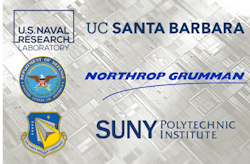AIM Photonics awards UCSB-led team $1.7 million to demo new waveguide platform
The American Institute for Manufacturing Integrated Photonics (AIM Photonics) has selected a team led by the University of California, Santa Barbara (UCSB) to develop a CMOS-compatible waveguide platform for integrating mid-wavelength and long-wavelength infrared (MWIR and LWIR) laser sources. The new platform is intended to address opportunities beyond the more established telecom wavelength range around 1550 nm, enabling commercial and military applications such as sensing atmospheric trace gases.
The $1.7 million Department of Defense (DoD) project will support a consortium of AIM Photonics members led by UCSB and including Northrop Grumman, the U.S. Naval Research Laboratory, and SUNY Polytechnic Institute. The partnership will add MWIR laser sources (nominally 3.0 μm < λ < 5.0 μm) and LWIR laser sources (nominally 8.0 μm < λ < 14.0 μm) into the capability offerings of AIM Photonics.
Related: New DoD, AIM Photonics partnership to create sensors for photonic systems
Related: AIM Photonics releases roadmap for U.S. integrated photonics
“The extension of photonic integrated circuits to MWIR and LWIR wavelengths may be expected to strongly impact Navy systems,” noted Jerry Meyer, Senior Scientist for Quantum Electronics at the U.S. Naval Research Laboratory. “They will be particularly valuable in systems requiring such advanced capabilities as IR power scaling, multispectral beam combining, high-resolution IR imaging, and chemical threat detection.”
Aside from DoD interests, there are numerous medical, bioenvironmental, remote sensing, communications, and manufacturing and process monitoring benefits that may be demonstrated through this work.
Source: AIM Photonics

Conard Holton
Conard Holton has 25 years of science and technology editing and writing experience. He was formerly a staff member and consultant for government agencies such as the New York State Energy Research and Development Authority and the International Atomic Energy Agency, and engineering companies such as Bechtel. He joined Laser Focus World in 1997 as senior editor, becoming editor in chief of WDM Solutions, which he founded in 1999. In 2003 he joined Vision Systems Design as editor in chief, while continuing as contributing editor at Laser Focus World. Conard became editor in chief of Laser Focus World in August 2011, a role in which he served through August 2018. He then served as Editor at Large for Laser Focus World and Co-Chair of the Lasers & Photonics Marketplace Seminar from August 2018 through January 2022. He received his B.A. from the University of Pennsylvania, with additional studies at the Colorado School of Mines and Medill School of Journalism at Northwestern University.
